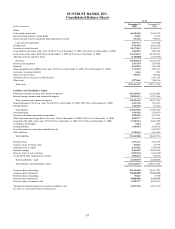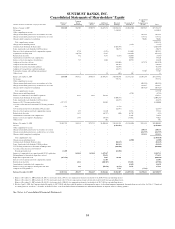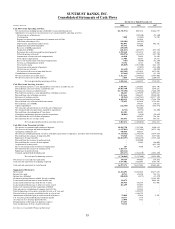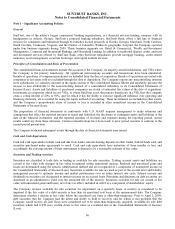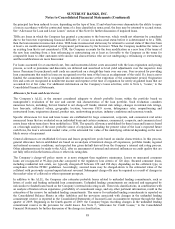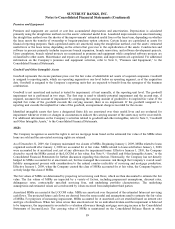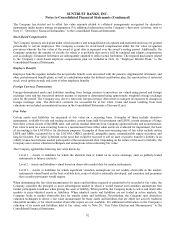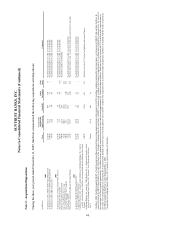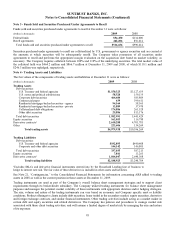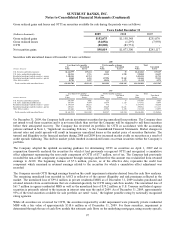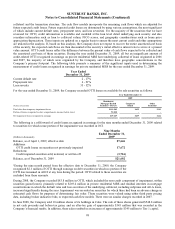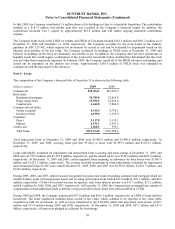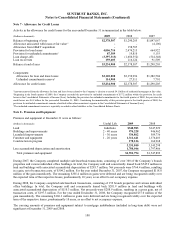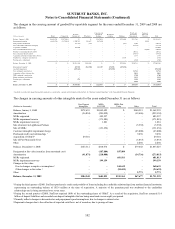SunTrust 2009 Annual Report Download - page 108
Download and view the complete annual report
Please find page 108 of the 2009 SunTrust annual report below. You can navigate through the pages in the report by either clicking on the pages listed below, or by using the keyword search tool below to find specific information within the annual report.SUNTRUST BANKS, INC.
Notes to Consolidated Financial Statements (Continued)
The Company has elected not to offset fair value amounts related to collateral arrangements recognized for derivative
instruments under master netting arrangements. For additional information on the Company’s derivative activities, refer to
Note 17, “Derivative Financial Instruments,” to the Consolidated Financial Statements.
Stock-Based Compensation
The Company sponsors stock plans under which incentive and nonqualified stock options and restricted stock may be granted
periodically to certain employees. The Company accounts for stock-based compensation under the fair value recognition
provisions whereby the fair value of the award at grant date is expensed over the award’s vesting period. Additionally, the
Company estimates the number of awards for which it is probable that service will be rendered and adjusts compensation
cost accordingly. Estimated forfeitures are subsequently adjusted to reflect actual forfeitures. The required disclosures related
to the Company’s stock-based employee compensation plan are included in Note 16, “Employee Benefit Plans,” to the
Consolidated Financial Statements.
Employee Benefits
Employee benefits expense includes the net periodic benefit costs associated with the pension, supplemental retirement, and
other postretirement benefit plans, as well as contributions under the defined contribution plan, the amortization of restricted
stock, stock option awards, and costs of other employee benefits.
Foreign Currency Transactions
Foreign denominated assets and liabilities resulting from foreign currency transactions are valued using period end foreign
exchange rates and the associated interest income or expense is determined using approximate weighted average exchange
rates for the period. The Company may elect to enter into foreign currency derivatives to mitigate its exposure to changes in
foreign exchange rates. The derivative contracts are accounted for at fair value. Gains and losses resulting from such
valuations are included as noninterest income in the Consolidated Statements of Income/(Loss).
Fair Value
Certain assets and liabilities are measured at fair value on a recurring basis. Examples of these include derivative
instruments, available for sale and trading securities, certain loans held for investment and LHFS, certain issuances of long-
term debt, certain classes of the MSR asset, and certain residual interests from Company-sponsored sales and securitizations.
Fair value is used on a non-recurring basis as a measurement basis either when assets are evaluated for impairment, the basis
of accounting is the LOCOM or for disclosure purposes. Examples of these non-recurring uses of fair value include certain
LHFS and MSRs accounted for at the LOCOM, OREO, goodwill, intangible assets, nonmarketable equity securities, and
long-lived assets. Fair value is defined as the price that would be received to sell an asset or paid to transfer a liability in an
orderly transaction between market participants at the measurement date. Depending on the nature of the asset or liability, the
Company uses various valuation techniques and assumptions when estimating fair value.
The Company applied the following fair value hierarchy:
Level 1 – Assets or liabilities for which the identical item is traded on an active exchange, such as publicly-traded
instruments or futures contracts.
Level 2 – Assets and liabilities valued based on observable market data for similar instruments.
Level 3 – Assets or liabilities for which significant valuation assumptions are not readily observable in the market;
instruments valued based on the best available data, some of which is internally developed, and considers risk premiums
that a market participant would require.
When determining the fair value measurement for assets and liabilities required or permitted to be recorded at fair value, the
Company considers the principal or most advantageous market in which it would transact and considers assumptions that
market participants would use when pricing the asset or liability. When possible, the Company looks to active and observable
markets to price identical assets or liabilities. When identical assets and liabilities are not traded in active markets, the
Company looks to market observable data for similar assets and liabilities. Nevertheless, the Company uses alternative
valuation techniques to derive a fair value measurement for those assets and liabilities that are either not actively traded in
observable markets or for which market observable inputs are not available. For additional information on the Company’s
valuation of its assets and liabilities held at fair value, refer to Note 20, “Fair Value Election and Measurement,” to the
Consolidated Financial Statements.
92



